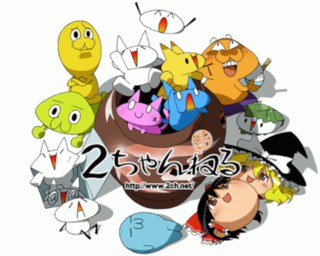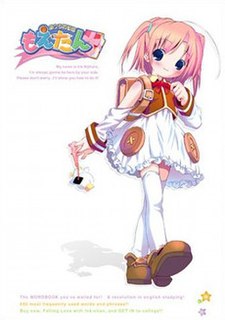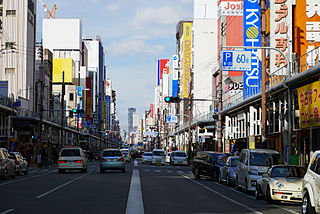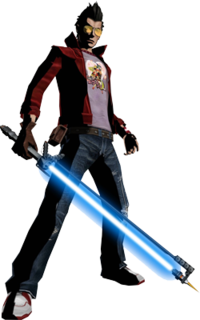 W
WOtaku is a Japanese term for people with consuming interests, particularly in anime and manga. Its contemporary use originated with a 1983 essay by Akio Nakamori in Manga Burikko. Otaku may be used as a pejorative; its negativity stemming from a stereotypical view of otaku as social outcasts and the media's reporting on Tsutomu Miyazaki, "The Otaku Murderer", in 1989. According to studies published in 2013, the term has become less negative, and an increasing number of people now identify themselves as otaku, both in Japan and elsewhere. Out of 137,734 teens surveyed in Japan in 2013, 42.2% self-identified as a type of otaku.
 W
W2channel , also known as 2ch, Channel 2, and sometimes retrospectively as 2ch.net, was an anonymous Japanese textboard founded in 1999 by Hiroyuki Nishimura. As "Japan's most popular online community, with around ten million users accessing it each day," it had a level of influence in society described as comparable to that of traditional mass media such as television, radio, and magazines. In 2007, the site had an annual revenue of around ¥100 million; it was then the largest site of its kind in the world, receiving 2.5 million posts per day.
 W
WAkihabara is a common name for the area around Akihabara Station in the Chiyoda ward of Tokyo, Japan. Administratively, the area called Akihabara mainly belongs to the Sotokanda (外神田) and Kanda-Sakumachō districts in Chiyoda. There exists an administrative district called Akihabara in the Taitō ward further north of Akihabara Station, but it is not the place people generally refer to as Akihabara.
 W
WAkishibu-kei is a loosely defined trend from the 2000s that involved an increase of Shibuya-kei influence in anime soundtracks. The term is a portmanteau of "Shibuya-kei" and "Akiba-kei". Both were 1990s cultural movements associated with musical and otaku interests, respectively, and Akishibu-kei was thought to have represented a merging of the two.
 W
WAn anime club is an organization that meets to discuss, show, and promote anime in a local community setting and can also focus on broadening Japanese cultural understanding. Anime clubs are increasingly found at universities and high schools. Organizers may also use public meeting spaces such as a library or a government center. Many anime club attendees identify themselves as otaku. Although the core of anime club attendees are in their twenties, there are generally no age requirements. Adults in their fifties and sixties and teenagers also attend.
 W
WComic Frontier, also widely known as Comifuro is a dōjinshi convention held bi-annually in Jakarta, Indonesia.
 W
WComic Market , more commonly known as Comiket and sometimes Comike , is a biannual dōjinshi fair in Tokyo, Japan. It is typically held at Tokyo Big Sight in August and December.
 W
WCosplay, a portmanteau of the words "costume play", is an activity and performance art in which participants called cosplayers wear costumes and fashion accessories to represent a specific character. Cosplayers often interact to create a subculture, and a broader use of the term "cosplay" applies to any costumed role-playing in venues apart from the stage. Any entity that lends itself to dramatic interpretation may be taken up as a subject. Favorite sources include anime, cartoons, comic books, manga, television series, and video games.
 W
WA dakimakura is a type of large pillow from Japan. The word is often translated to English as body pillow. In Japan, dakimakura are similar to Western orthopedic body pillows, and are commonly used by Japanese youth as "security objects".
 W
WA denpa song (電波ソング) is a type of Japanese music that is intentionally strange and catchy. Common features of denpa songs include intentionally off-key vocals, nonsensical lyrics and an over-the-top tune. Denpa music has grown into a subculture within Japan, forming a significant aspect of otaku culture and has large numbers of dōjin circles and music artists dedicated to denpa music. Denpa is not a specific genre in itself, but rather an umbrella term for various kinds of music.
 W
WDensha Otoko is a Japanese movie, television series, manga, novel, and other media, all based on the purportedly true story of a 23-year-old otaku who intervened when a drunk man started to harass several women on a train. The otaku ultimately began dating one of the women.
 W
WDensha Otoko is a Japanese television drama that aired on Fuji Television. It is based on the Densha Otoko story, which has also been portrayed in other media.
 W
WGenshiken is a manga series by Shimoku Kio about a college club for otaku and the lifestyle its members pursue. The title is a shortening of the club's official name, Gendai Shikaku Bunka Kenkyūkai (現代視覚文化研究会), or "The Society for the Study of Modern Visual Culture". The series has also been adapted into an anime directed by Tsutomu Mizushima. The manga originally ran in Kodansha's monthly manga anthology Afternoon from April 2002 to May 2006, and has been reprinted in nine bound volumes. The ninth and final volume was released in Japan in December 2006.
 W
WLucky Chloe , also known simply as Chloe, is a fictional character from the Tekken fighting game franchise by Bandai Namco Entertainment, making her debut in Tekken 7. She is a teenage girl wearing a black, pink and white kitten-themed costume, including cat ears, tail, and paws. She is described as an otaku, having an obsession with Japanese pop culture and speaking in Japanese and English with a Japanese accent. She is hired by G Corporation to be a mascot commercial.
 W
WTsutomu Miyazaki , also known as Otaku Murderer or the Little Girl Murderer, was a Japanese serial killer, cannibal, child rapist and necrophile who murdered four young girls in Tokyo and Saitama Prefecture between August 1988 and June 1989.
 W
WA model figure is a scale model representing a human, monster or other creature. Human figures may be either a generic figure of a type, a historical personage, or a fictional character.
 W
WMoetan (もえたん) is a series of English language study aids published by SansaiBooks in Japan. Targeted at otaku, it attempted to teach English words using examples drawn from computer games and anime.
 W
WTakashi Murakami is a Japanese contemporary artist. He works in fine arts media as well as commercial media and is known for blurring the line between high and low arts. He coined the term "superflat", which describes both the aesthetic characteristics of the Japanese artistic tradition and the nature of postwar Japanese culture and society, and is also used for Murakami's artistic style and other Japanese artists he has influenced.
 W
WNipponbashi (日本橋) is a shopping district of Naniwa Ward, Osaka, Japan. The area is centered along Sakaisuji Avenue, extending from the Ebisu-chō Interchange of the Hanshin Expressway in the south, to Nansan-dōri in the north. Known colloquially as "Den-Den Town," Nipponbashi is known for its many shops which specialize in furniture, tools, and "otaku" interests such as electronics, anime, manga, and collectibles. Nipponbashi is often compared to Akihabara Electric Town, its equivalent in Tokyo.
 W
WThe Otaku Encyclopedia is a 2009 encyclopedia written by Patrick Galbraith and published by Kodansha which provides an overview of anime and manga topics, and interviews and profiles of important people in Japanese fandom.
 W
WOtaku no Video is a 1991 anime spoofing the life and culture of otaku, individuals with obsessive interests in media, particularly anime and manga, as well as the history of Gainax, its creators. It is noted for its mix of conventional documentary film styles, with a more traditional anime storytelling fashion. It is licensed in the United States by AnimEigo. The DAICON III and IV Opening Animations from the early eighties are also featured in this OVA.
 W
WOtome Road is a name given to an area of Ikebukuro, Tokyo, Japan that is a major shopping and cultural center for anime and manga aimed at women. The area is sometimes referred to as Fujoshi Street, referencing the name given to fans of yaoi.
 W
WTokusatsu is a Japanese term for live action film or television drama that makes heavy use of special effects. Tokusatsu entertainment often deals with science fiction, fantasy or horror, but films and television shows in other genres can sometimes count as tokusatsu as well. The most popular types of tokusatsu include kaiju monster films such as the Godzilla and Gamera film series; superhero TV serials such as the Kamen Rider and Metal Hero series; and mecha dramas like Giant Robo and Super Robot Red Baron. Some tokusatsu television programs combine several of these subgenres, for example the Ultraman and Super Sentai series.
 W
WTravis Touchdown is a fictional character and the main antihero of the video game franchise No More Heroes. 27 years old in the original game, he is both an otaku and a professional assassin, wielding a Beam Katana. He was created by Goichi Suda, and voiced by Kazuya Nakai in Japanese and Robin Atkin Downes in English.
 W
WA virtual YouTuber or VTuber is an online entertainer that uses a digital avatar generated using computer graphics. A growing trend that originated in Japan in the mid-2010s, a majority of VTubers are Japanese-speaking YouTubers or live streamers who use anime-inspired avatar designs. By 2020, there were more than 10,000 active VTubers.